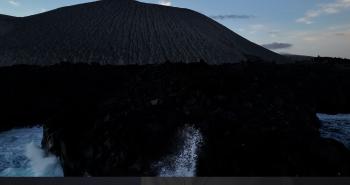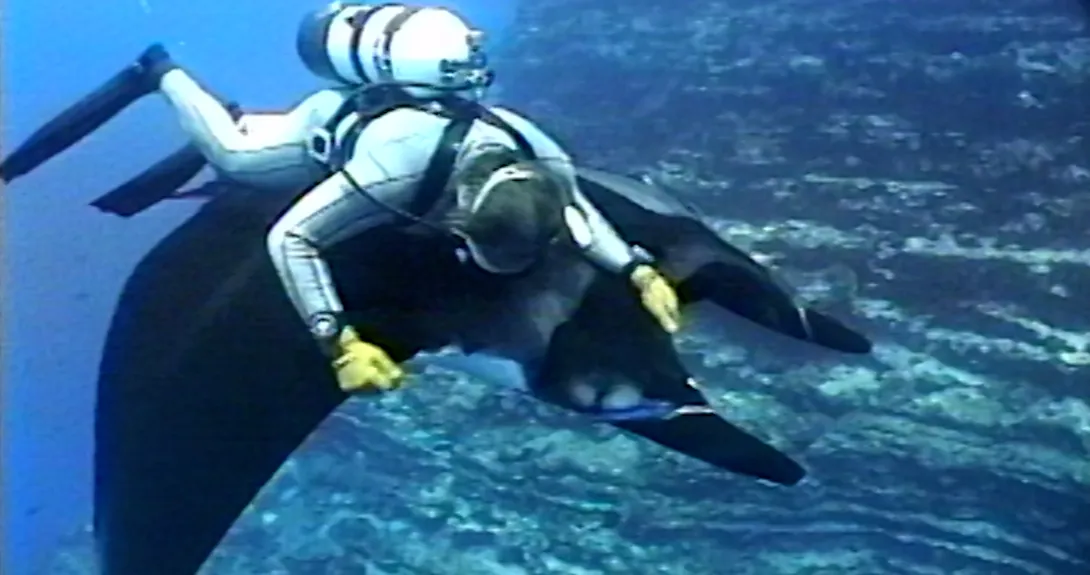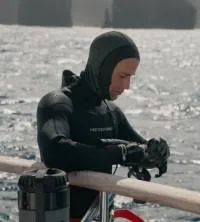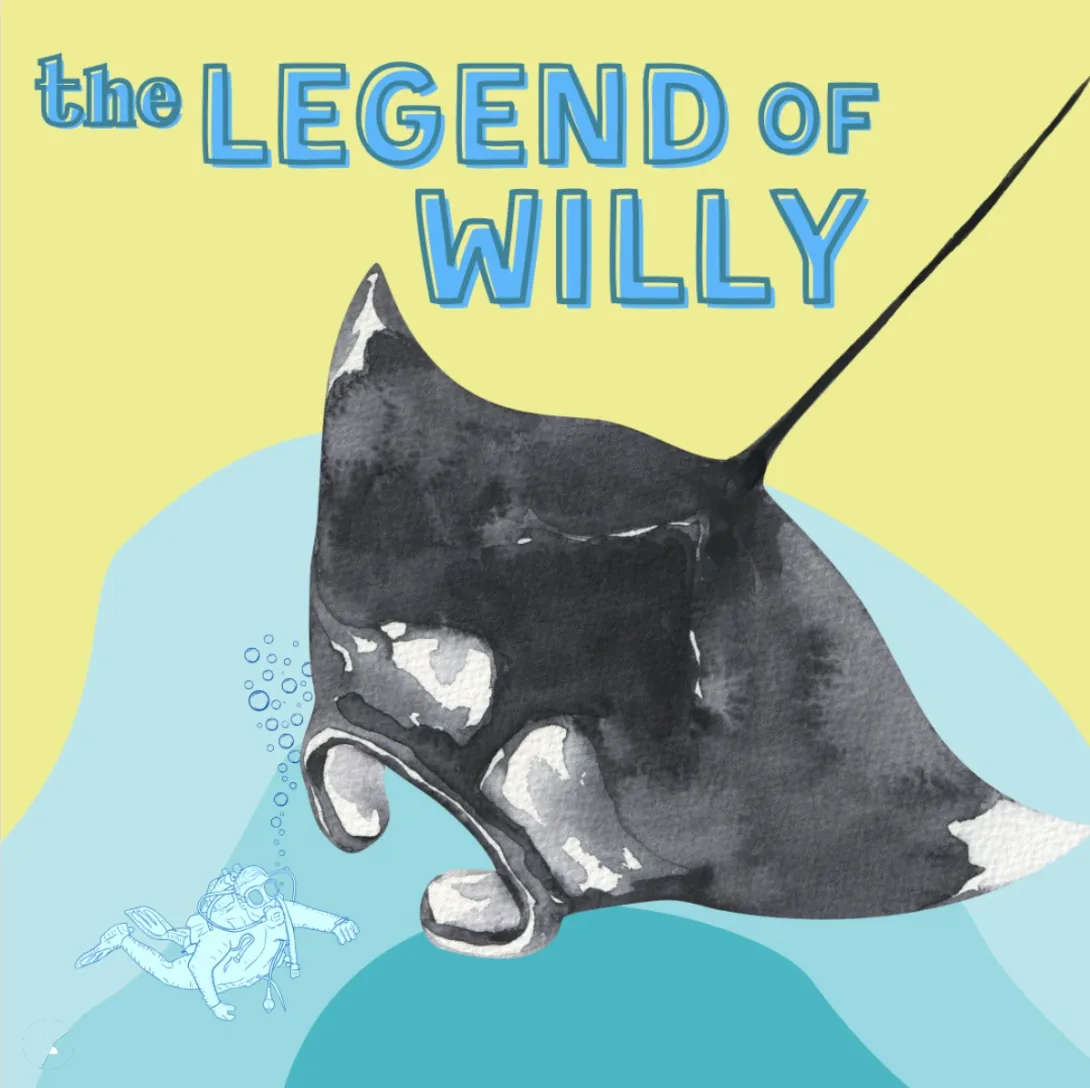The waters around Isla San Benedicto are filled with sea life and feel both welcoming and humbling. Above the water, this volcanic monolith is as hostile to humans as any distant planet. Its steep sides are gouged vertically, as if a comb was taken to a soft clay pot. Dark waters seeth at jagged black rocks all around its base. Above, the island is raw and stark; below, it is an orchestra of light, movement, and a labyrinth of underwater ridges, pinnacles, and caves. To venture here is to surrender to the realm of the giant Pacific Mantas. The last stable population of these, 20 foot wide creatures live here, but one in particular, named Willy, has become a legend. We need to find him and if anyone has any information about Willy, or giant Mantas in general, we would love to connect with you.

Our dive team descended into a twilight world, weightless, breathing through regulators, and feeling a false sense of safety in the compression of our wetsuits. Hammerheads emerged first, their silhouettes cutting through the dim blue. They moved like primal logic, stripped of embellishment, unflinching in their precision. They were equations in motion, perfect expressions of purpose—silent and efficient. They passed with an indifference so complete it bordered on disdain, their cold, ancient eyes offering no acknowledgment of my presence. I felt small, a fleeting moment of consciousness in a universe vast beyond comprehension. Then, as if on cue, the hammerheads vanished into the blue. A profound stillness followed, and I held my breath, sensing the arrival of something extraordinary.
The mantas came, gliding in from the void. Their wings moved with a grace that defied their massive size, each stroke a quiet miracle. They didn't rush toward us but arrived as if they had always been there, materializing from the depths. One by one, they circled, their presence gentle but commanding. Each manta bore its own story written in the language of patterns and scars. I searched for the one I had come to find—Willy, the legendary giant. His markings were said to be unmistakable: four black dots in a diamond formation on his right shoulder. The Pacific Manta Research Group (PRMG) has long maintained a database for identifying individuals. None of these creatures bore his signature. My disappointment was tempered by awe. One manta, larger than the rest, lingered.
She was not Willy, yet she commanded attention. Her eyes—large, unblinking—met mine with an intensity that unsettled and enthralled me. In her gaze, there was no malice, no fear. There was something more profound: acknowledgement. For a fleeting moment, the barriers of species, intelligence, and experience dissolved. We were two beings, alive in the same fragile instant, suspended in a vast ocean of existence.
What does it mean to be conscious? I have often wondered this, but in her presence, the question felt urgent. Scientists like Dr. Bob Rubin, the founder of PMRG, has revealed the astonishing minds of Pacific mantas. Their warm brains enable rapid, advanced cognition. The use electrical fields to perceive animals around them and can distinguish between different human divers. They've passed the mirror test, proving self-awareness, and their curiosity hints at something deeper—a consciousness that feels strikingly familiar. Mantas are part of a special club that includes humans, other primates, elephants, Ravens and dolphins. Bob gives a great TEDx talk where he explains even more about these remarkable creatures. Yet all the science in the world cannot prepare you for the moment when one of these creatures chooses to acknowledge you. It is not their intelligence that captivates but their presence—a resonance that lingers long after they vanish.
As she drifted closer, I reached out, not to touch but to signal that I also acknowledged her. My instinct was to do that with my hands, as I wasn't equipped with whatever force she seemed to project. She held her position. It felt less like an encounter and more like a conversation, wordless yet profound.

This creature was not Willy. The stories I had heard of him—how he carried children on his back, guided divers to ghost fishing nets that were clogging the reef, and shared a bond with a sailor named Terry—have made him a legend. Once, a group of divers were out near the canyon when out of the dark, Willy came rising up to the surface. Terry was riding on his back and casually looked over at them and waved. Those who have come to know Willy, swear by his uncanny curiosity. They are beginning to worry, though, as he has not been seen in many years. His last official sighting was in 2017. In recent years, sailors visiting the island have described a huge ray that could be Willy so we came here with high hopes. Now, with each passing day, the absence of his familiar silhouette gliding through the deep weighs heavier. Where has Willy gone?
While science has begun to unravel the mysteries of manta rays, much about their lives remains an enigma. These majestic creatures are known to travel vast distances across the ocean, though researchers have yet to determine just how far their journeys can take them. Similarly, while mantas are believed to live long lives, the exact span of their years is still unknown, adding to their aura of mystery. Willy has not been seen for some time now, but this absence is not unprecedented. There are tales of other mantas disappearing into the vastness of the ocean, only to reappear two decades later as if no time had passed. Perhaps Willy, too, is out there, exploring uncharted waters, searching for something we cannot comprehend. The ocean is a boundless realm, and in its infinite depths, time itself seems to stretch and blur. For all we know, Willy is still gliding through the blue, his story far from over.
My manta still hovered in front of me and I could only see one of her eyes. The other was four feet away on the opposite side of her huge mouth. Her eye was a tunnel of purple light with an unending depth. At that moment, everything else fell away. There was an intelligence in her gaze, an awareness. I felt as though she was curious about me too. It was a connection—brief, fragile, yet profound.
I thought of Willy and his friendship with Terry that had lasted for more than 20 years. Terry says that Willy was his best friend and that WIlly would come to his boat every day, slap a wing on the hull, and that was the signal for Terry to jump in the water and go play. Was it possible that this manta, staring at me with such depth, could develop a friendship with me at this level?
As the dive ended, the manta drifted away, disappearing into the blue like a dream fading with the dawn. I surfaced into the thin air of my world, the volcanic silhouette of San Benedicto stark against the sky. I hadn't found Willy, but in some strange way, I had found a greater insight into what Terry and Willy's friendship might have been. This manta—her curiosity, her stillness, her presence—left an impression on me that I will never forget.
Will we ever see Willy again? Maybe Willy is wondering why Terry hasn't come back to see him and he is out on his own search. Life, whether human or manta, represents an enigma that goes far beyond the mechanics of biology itself. And perhaps it is this search for connection, more than anything else, that makes humans and mantas extraordinary.
For anyone in the Sea of Cortez who might have seen Willy, please contact us via the form below. For anyone going to the Revillagigidos or Isla San Benedicto in particular, please contact us for more information about how to ID Willy.

About the author - Cody Sheehy is a diver, sailor, and filmmaker. He is helping to search for Willy and will be making regular updates at this website.
